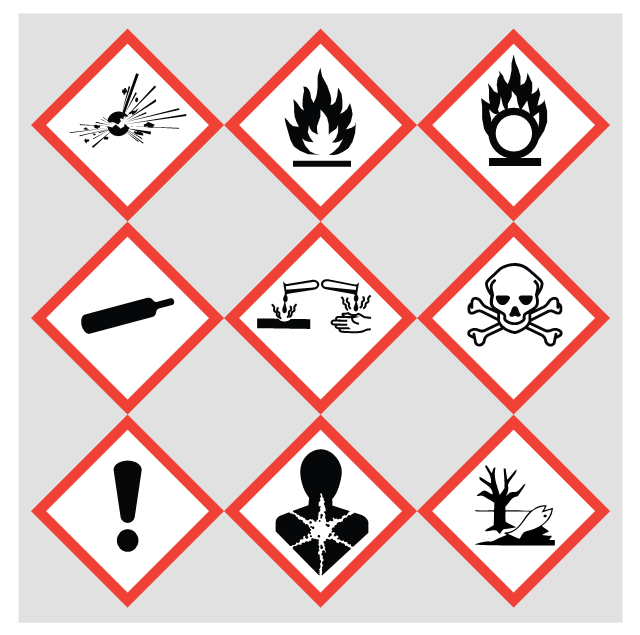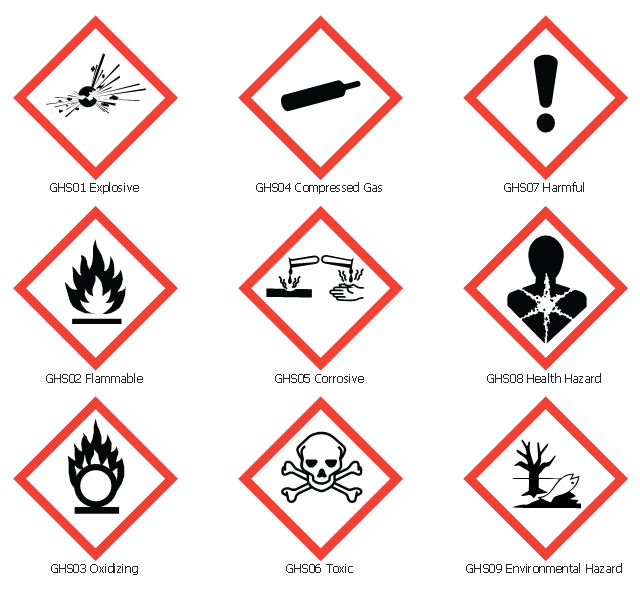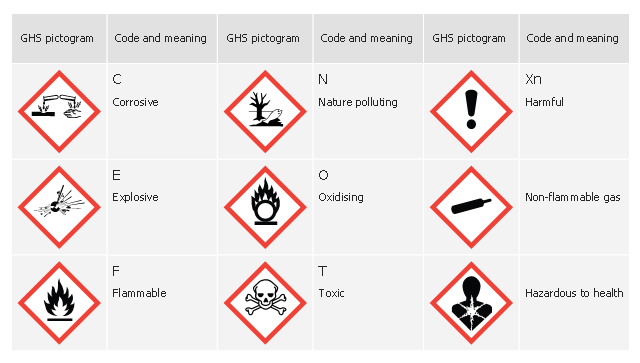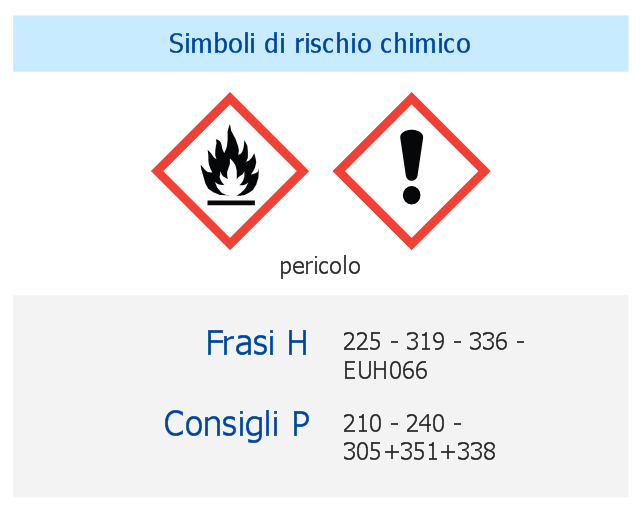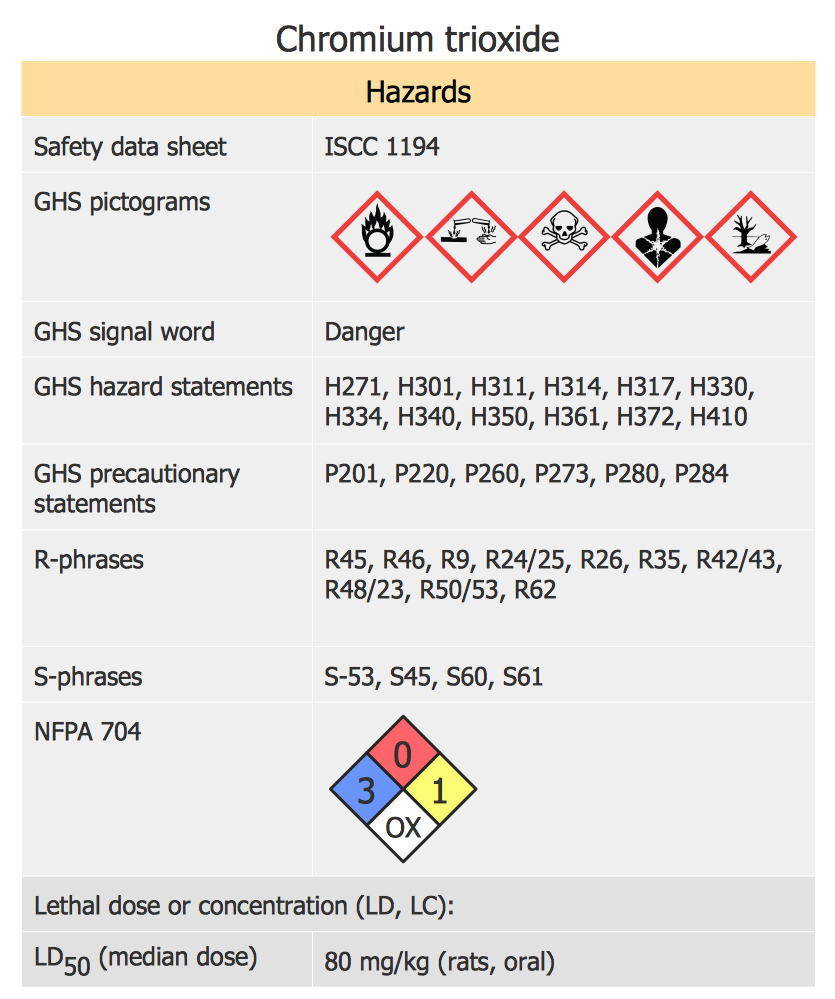This chemical safety infographic example shows the GHS chemical hazard pictograms poster.
It was designed on the base of the table from the Wikimedia Commons file: GHS HAZCOM Safety Labels.jpg. [commons.wikimedia.org/ wiki/ File:GHS_ HAZCOM_ Safety_ Labels.jpg]
"The Hazard Communication Standard requires employers to disclose toxic and hazardous substances in workplaces. This is related to the Worker Protection Standard.
Specifically, this requires unrestricted employee access to the Material Safety Data Sheet or equivalent, and appropriate training needed to understand health and safety risks. ...
The Globally Harmonized System of Classification and Labeling of Chemicals (GHS) is currently being pursued to standardize workplace hazard protection internationally." [Hazard Communication Standard. Wikipedia]
The chemical safety infographic sample "GHS HAZCOM Safety Labels" was created using ConceptDraw PRO software extended with the GHS Hazard Pictograms solution from the Engineering area of ConceptDraw Solution Park.
It was designed on the base of the table from the Wikimedia Commons file: GHS HAZCOM Safety Labels.jpg. [commons.wikimedia.org/ wiki/ File:GHS_ HAZCOM_ Safety_ Labels.jpg]
"The Hazard Communication Standard requires employers to disclose toxic and hazardous substances in workplaces. This is related to the Worker Protection Standard.
Specifically, this requires unrestricted employee access to the Material Safety Data Sheet or equivalent, and appropriate training needed to understand health and safety risks. ...
The Globally Harmonized System of Classification and Labeling of Chemicals (GHS) is currently being pursued to standardize workplace hazard protection internationally." [Hazard Communication Standard. Wikipedia]
The chemical safety infographic sample "GHS HAZCOM Safety Labels" was created using ConceptDraw PRO software extended with the GHS Hazard Pictograms solution from the Engineering area of ConceptDraw Solution Park.
The vector stencils library "GHS hazard pictograms" contains 9 chemical hazard symbols.
Use it in ConceptDraw PRO software to design your chemical safety infographics, labels of containers with hazardous materials, International Chemical Safety Cards (ICSC), manufacturers' Safety Data Sheets (SDS), and Material Safety Data Sheets (MSDS).
"Hazard pictograms form part of the international Globally Harmonized System of Classification and Labelling of Chemicals (GHS). Two sets of pictograms are included within the GHS: one for the labelling of containers and for workplace hazard warnings, and a second for use during the transport of dangerous goods. ...
Hazard pictograms are one of the key elements for the labelling of containers under the GHS, along with:
- an identification of the product;
- a signal word – either Danger or Warning – where necessary;
- hazard statements, indicating the nature and degree of the risks posed by the product;
- precautionary statements, indicating how the product should be handled to minimize risks to the user (as well as to other people and the general environment);
- the identity of the supplier (who might be a manufacturer or importer)." [GHS hazard pictograms. Wikipedia]
The chemical hazard symbols example "Design elements - GHS hazard pictograms" is included in the GHS Hazard Pictograms solution from the Engineering area of ConceptDraw Solution Park.
Use it in ConceptDraw PRO software to design your chemical safety infographics, labels of containers with hazardous materials, International Chemical Safety Cards (ICSC), manufacturers' Safety Data Sheets (SDS), and Material Safety Data Sheets (MSDS).
"Hazard pictograms form part of the international Globally Harmonized System of Classification and Labelling of Chemicals (GHS). Two sets of pictograms are included within the GHS: one for the labelling of containers and for workplace hazard warnings, and a second for use during the transport of dangerous goods. ...
Hazard pictograms are one of the key elements for the labelling of containers under the GHS, along with:
- an identification of the product;
- a signal word – either Danger or Warning – where necessary;
- hazard statements, indicating the nature and degree of the risks posed by the product;
- precautionary statements, indicating how the product should be handled to minimize risks to the user (as well as to other people and the general environment);
- the identity of the supplier (who might be a manufacturer or importer)." [GHS hazard pictograms. Wikipedia]
The chemical hazard symbols example "Design elements - GHS hazard pictograms" is included in the GHS Hazard Pictograms solution from the Engineering area of ConceptDraw Solution Park.
This chemical safety infographic example shows the table of GHS hazard pictograms, their codes and meanings.
It was designed on the base of the table from the Wikimedia Commons article "GHS hazard symbols".
"Hazard symbols or warning symbols are recognisable symbols designed to warn about hazardous materials, locations, or objects, including electric currents, poisons, and radioactivity. The use of hazard symbols is often regulated by law and directed by standards organisations. Hazard symbols may appear with different colors, backgrounds, borders and supplemental information in order to specify the type of hazard. Warning symbols are used in many places in lieu of or addition to written warnings as they are quickly recognized (faster than reading a written warning) and more universally understood (the same symbol can be recognized as having the same meaning to speakers of different languages)." [Hazard symbol. Wikipedia]
The chemical safety infographic sample "GHS hazard symbols" was created using ConceptDraw PRO software extended with the GHS Hazard Pictograms solution from the Engineering area of ConceptDraw Solution Park.
It was designed on the base of the table from the Wikimedia Commons article "GHS hazard symbols".
"Hazard symbols or warning symbols are recognisable symbols designed to warn about hazardous materials, locations, or objects, including electric currents, poisons, and radioactivity. The use of hazard symbols is often regulated by law and directed by standards organisations. Hazard symbols may appear with different colors, backgrounds, borders and supplemental information in order to specify the type of hazard. Warning symbols are used in many places in lieu of or addition to written warnings as they are quickly recognized (faster than reading a written warning) and more universally understood (the same symbol can be recognized as having the same meaning to speakers of different languages)." [Hazard symbol. Wikipedia]
The chemical safety infographic sample "GHS hazard symbols" was created using ConceptDraw PRO software extended with the GHS Hazard Pictograms solution from the Engineering area of ConceptDraw Solution Park.
This chemical safety infographic example shows the diethylzinc GHS-label including GHS hazard pictograms.
It was designed on the base of the table from the Wikimedia Commons file: GHS Diethylzink.png. [commons.wikimedia.org/ wiki/ File:GHS_ Diethylzink.png]
"Diethylzinc (C2H5)2Zn, or DEZ, is a highly pyrophoric organozinc compound consisting of a zinc center bound to two ethyl groups. This colourless liquid is an important reagent in organic chemistry and available commercially as a solution in hexanes, heptane, or toluene." [Diethylzinc. Wikipedia]
The german chemical safety infographic sample "Diethylzink" was created using ConceptDraw PRO software extended with the GHS Hazard Pictograms solution from the Engineering area of ConceptDraw Solution Park.
It was designed on the base of the table from the Wikimedia Commons file: GHS Diethylzink.png. [commons.wikimedia.org/ wiki/ File:GHS_ Diethylzink.png]
"Diethylzinc (C2H5)2Zn, or DEZ, is a highly pyrophoric organozinc compound consisting of a zinc center bound to two ethyl groups. This colourless liquid is an important reagent in organic chemistry and available commercially as a solution in hexanes, heptane, or toluene." [Diethylzinc. Wikipedia]
The german chemical safety infographic sample "Diethylzink" was created using ConceptDraw PRO software extended with the GHS Hazard Pictograms solution from the Engineering area of ConceptDraw Solution Park.
This italian chemical safety infographic example shows the ethyl acetate infobox including 3 sections: GHS hazard pictograms, Hazard statements and Precautionary statements.
It was designed on the base of the table from the Wikimedia Commons file: Consigli P.png. [commons.wikimedia.org/ wiki/ File:Consigli_ P.png]
"Ethyl acetate is the organic compound with the formula CH3–COO–CH2–CH3. This colorless liquid has a characteristic sweet smell (similar to pear drops) and is used in glues, nail polish removers, decaffeinating tea and coffee, and cigarettes (see list of additives in cigarettes). Ethyl acetate is the ester of ethanol and acetic acid; it is manufactured on a large scale for use as a solvent." [Ethyl acetate. Wikipedia]
The chemical safety infographic sample "Acetato di etile" was created using ConceptDraw PRO software extended with the GHS Hazard Pictograms solution from the Engineering area of ConceptDraw Solution Park.
It was designed on the base of the table from the Wikimedia Commons file: Consigli P.png. [commons.wikimedia.org/ wiki/ File:Consigli_ P.png]
"Ethyl acetate is the organic compound with the formula CH3–COO–CH2–CH3. This colorless liquid has a characteristic sweet smell (similar to pear drops) and is used in glues, nail polish removers, decaffeinating tea and coffee, and cigarettes (see list of additives in cigarettes). Ethyl acetate is the ester of ethanol and acetic acid; it is manufactured on a large scale for use as a solvent." [Ethyl acetate. Wikipedia]
The chemical safety infographic sample "Acetato di etile" was created using ConceptDraw PRO software extended with the GHS Hazard Pictograms solution from the Engineering area of ConceptDraw Solution Park.
HelpDesk
How To Design Regulatory Documents with use of Standard GHS Pictograms
A hazard pictogram is intended to provide information about the hazard that can cause a damage of a human health or the environment. GHS Hazard pictogram consists from a standard hazard symbol placed to the shape of a red diamond with a white background. GHS Hazard Pictograms solution from the ConceptDraw Solution Park includes the set of standardized GHS hazard pictograms. It can be used for creating safety infographics, warning announcements, labels and regulatory documentation containing the elements of OSHA HAZCOM Standard.
 GHS Hazard Pictograms
GHS Hazard Pictograms
GHS Hazard Pictograms solution contains the set of predesigned standard GHS pictograms, Hazardous symbols, and Hazard communication pictograms, approved and agreed by UN in Globally Harmonized System of Classification and Labelling of Chemicals (GHS). They can be used for quick and simple designing accurate and professional-looking infographics, diagrams, warning announcements, signboards, posters, precautionary declarations, regulatory documents, and for representing the main items of OSHA HAZCOM Standard.
This chemical safety infographic example shows the diethylzinc GHS-label including GHS hazard pictograms.
It was designed on the base of the table from the Wikimedia Commons file: GHS Diethylzink.png. [commons.wikimedia.org/ wiki/ File:GHS_ Diethylzink.png]
"Diethylzinc (C2H5)2Zn, or DEZ, is a highly pyrophoric organozinc compound consisting of a zinc center bound to two ethyl groups. This colourless liquid is an important reagent in organic chemistry and available commercially as a solution in hexanes, heptane, or toluene." [Diethylzinc. Wikipedia]
The german chemical safety infographic sample "Diethylzink" was created using ConceptDraw PRO software extended with the GHS Hazard Pictograms solution from the Engineering area of ConceptDraw Solution Park.
It was designed on the base of the table from the Wikimedia Commons file: GHS Diethylzink.png. [commons.wikimedia.org/ wiki/ File:GHS_ Diethylzink.png]
"Diethylzinc (C2H5)2Zn, or DEZ, is a highly pyrophoric organozinc compound consisting of a zinc center bound to two ethyl groups. This colourless liquid is an important reagent in organic chemistry and available commercially as a solution in hexanes, heptane, or toluene." [Diethylzinc. Wikipedia]
The german chemical safety infographic sample "Diethylzink" was created using ConceptDraw PRO software extended with the GHS Hazard Pictograms solution from the Engineering area of ConceptDraw Solution Park.
- Design elements - GHS hazard pictograms | GHS HAZCOM Safety ...
- GHS HAZCOM Safety Labels | Design elements - GHS hazard ...
- GHS Hazard Pictograms | GHS hazard symbols | Design elements ...
- Design elements - GHS hazard pictograms
- Design Pictorial Infographics. Design Infographics | OSHA HAZCOM ...
- OSHA HAZCOM pictograms | Design elements - HR professions ...
- GHS Hazard Pictograms | How To Design Regulatory Documents ...
- Hazard Chemical Sign | Chemical Engineering | Transport Hazard ...
- Hazard Chemical Sign | GHS Hazard Pictograms | Fire and ...
- GHS Hazard Pictograms | Transport Hazard Pictograms | Hazard ...
